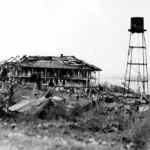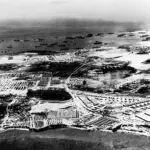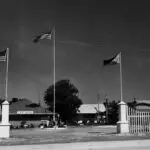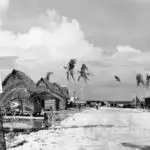Rebuilding from the Destruction of War
Table of Contents
Share This
Post War Guam
The atrocities of World War II had a major impact on the CHamoru people. They had suffered much under Japanese rule and, therefore, were largely appreciative and loyal to the Americans for their liberation from the Japanese. However, after the war, many CHamorus were displaced from their ranches and residences.
The retaking of Guam by the US and the push to end the war allowed for the influx of more than 200,000 US military personnel into Guam. This increase in military also brought many new people to Guam who fell in love with the island and its people and stayed. Some came for business opportunities, or to work with the naval government; others came to entertain the troops. Workers were also brought in from the Philippines and lived in large camps such as Camp Roxas to help rebuild the island. Some of these workers also stayed and began families of their own on Guam.
During the American invasion, the major villages of Sumai and Hagåtña had been heavily bombed, leaving CHamorus to face a devastated island. Large tracts of land were taken to support the larger US military presence. Sumai was absorbed as part of Naval Station and its residents were placed in the newly established village of Sånta Rita-Sumai. Much of the debris from the bombing of Hagåtña was pushed out into the bay to create what is now the Paseo, where the baseball stadium and CHamoru Village are located. However, many families who had to give up their land were not adequately compensated by the US military; some also refused to accept money in protest of their lost land.
Schools, churches and public administrative buildings were rebuilt and reopened. At the request of the American bishop on Guam, religious sisters from the United States were brought in for the first time to set up schools and assist in the development of the island’s Catholic school system. They also set up convents for young women who wanted a vocation in religious life. The first Liberation Day commemorations began as solemn religious affairs but gradually became more celebratory, with parades, carnivals and a Liberation Queen.
Land issues and the struggle for human rights compelled the CHamorus to once again try to gain political control of their island home. A newly appointed Guam Congress struggled with the naval leadership and eventually walked out of session decrying the lack of democracy. A like-minded group of people in Washington DC, the Institute of Ethnic Affairs, helped lobby for the passage of an organic act. President Harry Truman finally signed the Organic Act on 1 August 1950, which solidified Guam’s status as an unincorporated territory, and essentially established the Government of Guam while granting American citizenship to the local CHamoru population.
Political and Social Change
At the end of World War II, Guam was again placed under the control of the US Navy. Guam remained politically separated from the Northern Mariana Islands, which were placed with Japan’s other Micronesian territories of Palau, Yap, Pohnpei, Kosrae, Chuuk and the Marshall Islands under a United Nations trust to form the US Trust Territory of Pacific Islands (TTPI) to be administered by the US.
By the 1950s, with a new civilian government in place and the end of naval rule, the people of Guam began to forge a new direction towards modernity, urbanization and enjoying the opportunities of an American way of life. The term “Guamanian” reflected a new kind of identity and outlook for the people of Guam, who had survived the atrocities of war. Civilian governors were appointed by the president of the US. However, Cold War politics after World War II increased the US’ strategic and military interest in the region, and so Guam maintained large military bases on different ends of the island.
In 1952, the Territorial College of Guam was established by Governor Carlton Skinner. The college moved to its present location in Mangilao, and became the University of Guam in 1965.
In 1960, Joseph Flores was appointed the first CHamoru governor of Guam and served a one-year term. In 1962 President John F. Kennedy lifted the security clearance that had restricted entry into Guam since 1941. With this order, the island was opened up for tourism to blossom as an industry. The easing of military restrictions for entering Guam and the establishment of a local, civilian government, made the island an ideal place for people from all over the world to visit, go to school, find jobs or pursue a variety of economic interests.
In 1963, under the second CHamoru Governor Manuel FL Guerrero, the Guam Tourism Commission was established. The Guam International Airport opened in 1967, and the first flights from Japan via Pan Am arrived on-island. By the end of the 1960s and into the 1970s, Tumon Bay became the focus of a new wave of construction for numerous high-rise hotels, condominiums and entertainment venues. Other large housing developments popped up in a construction boom that coincided with Asian economic prosperity of the 1980s. Today, next to the Government of Guam, the tourist industry is the second largest employer of the local population.
On the political front, the end of the 1960s saw the US Congress pass laws allowing gubernatorial elections on Guam, and elections for non-voting congressional representatives for each of the territories. In 1970 Guam elected its first governor, Carlos G. Camacho, and in 1972, its first congressional representative, Antonio B. Won Pat.
Challenges and the Future
The decades following the war brought new challenges for Guam. With population changes came numerous social, political and economic issues for the local community to face. One such issue was the need to assess and protect CHamoru culture and language. CHamoru language was introduced into school curricula and public building signage. Inspired by other Pacific Islanders, local artists, writers and musicians began exploring ways of including or expressing CHamoru cultural motifs in their works. In some respects, the influx of visitors to Guam and the desire to feature and showcase the island’s unique attributes has advanced the tourist industry and caused a resurgence or renaissance of CHamoru culture and history.
Another challenge has been the strain on local resources with the increase in population. In the 1970s and 1980s, the US had entered into political compacts of free association with the former trust territory islands. The compacts allowed their citizens to enter Guam and the US in search of better education and employment opportunities. While many of these individuals work and pay taxes into the local economy, the federal government has not adequately compensated places like Guam for the impact the compacts have had on the island community.
Unlike these islands, though, Guam’s political status has remained an unresolved issue. Island leaders pursued commonwealth status with the US government throughout the 1980s and 1990s. However, the Commonwealth Act was never accepted by the US Congress. Since then, the people of Guam have not been able to show a united front on issues of political status or address decolonization and forge a different relationship with the US.
Today, the island must navigate a future that includes a large military buildup that has the potential for significant economic, environmental and social benefits and impacts on the people, the landscape of Guam and the rest of the Mariana Islands. If history has revealed anything, however, it is that the people of Guam are resilient even in the face of such formidable challenges, but also, that they cannot afford to forget the lessons of the past when deciding the future of our island.




